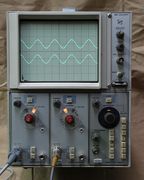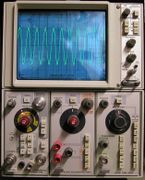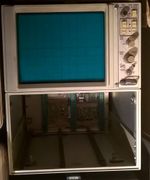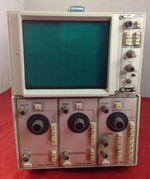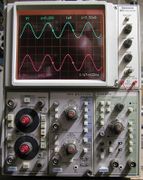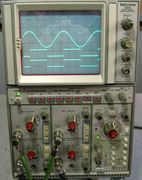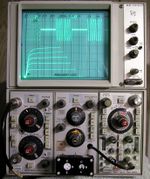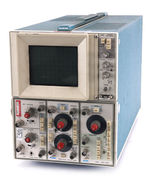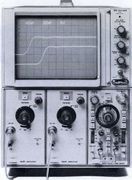|
|
| (15 intermediate revisions by 5 users not shown) |
| Line 1: |
Line 1: |
| Tektronix 5000-series scopes are described on the [http://www.i9t.net/5000_scopes.html iceNINE Tech] webpage. | | The '''Tektronix 5000-series''' was a range of lower-speed modular scopes made from 1971 to 1991, covering target markets like mechanical or biomedical instrumentation, or audio. They complemented the high-end, modular [[7000-series scopes|7000 series]] of lab instruments. |
|
| |
|
| See also [[:Category:5000 series scopes]]
| | The [[5000-series plug-ins]] look mechanically similar to the 7000-series. They have the same front panel dimensions but |
| | the 5000-series plug-ins are shorter, and the mainframe interface is not compatible, it is even using different supply voltages. |
| | However, there are some plug-in modules that come in almost identical 5000- and 7000-series versions, e.g. the [[7S14]]/[[5S14N]] sampler or [[7CT1N]]/[[5CT1N]] curve tracer. |
|
| |
|
| Introduction to the 5000-Series Oscilloscopes | | See the [[Introduction to the 5000-Series Oscilloscopes]] and the excellent [http://www.i9t.net/5000_scopes.html iceNINE Tech] web pages for further information. |
|
| |
|
| The Basics of the 5000-Series
| | ===51xx (slow) mainframes=== |
| | Compatible with slower 5X1x and 5X2x [[5000-series plug-ins]]. |
| | <gallery widths="150" heights="180"> |
| | Tek 5110.jpg | '''[[5110]]''' aka [[5103]]/[[D10]] — 2 MHz (1976–1991) |
| | 5111.jpg | '''[[5111]]''' aka [[5103]]/[[D11]] — 2 MHz storage (1976–1991) |
| | 5112.jpg | '''[[5112]]''' aka [[5103]]/[[D12]] — 2 MHz dual-beam (?-?) |
| | 5113.jpg | '''[[5113]]''' aka [[5103]]/[[D13]] — 2 MHz dual-beam storage (?-?) |
| | Tek 5115 benchtop.jpg | '''[[5115]]''' aka [[5103]]/[[D15]] — 2 MHz fast storage (?–?) |
| | 5116.jpg | '''[[5116]]''' — 2 MHz Color LCD shutter (1984–1987) |
| | </gallery> |
|
| |
|
| The 5000-series (5K) was introduced in 1971 as lower-cost, laboratory oscilloscope
| | ===5223 digital storage mainframe=== |
| instrumentation with plug-in versatility. This series generally has larger display
| | Compatible with most [[5000-series plug-ins]]. |
| screens than the more-expensive and higher-performance 7000-series, but also has
| | <gallery widths="150" heights="180"> |
| very low bandwidth in comparison.
| | 5223 1 crop.jpg | '''[[5223]]''' — 10 MHz/100 kHz/10 MS/s digital (1981–1988) |
| | | </gallery> |
| Unlike other Tektronix products other than the 7704A in the 7000-series, the
| |
| 5000-series mainframes consist of an acquisition unit (the 5103 or 5403) containing
| |
| the plug-in compartments and low-voltage power supply and a display unit (e.g., the
| |
| D10, D11, D12, D13, etc.). The idea was that the display unit could be sold
| |
| separately for custom integrated uses by other manufacturers at a lower cost than
| |
| could be had by using one of the 600-series monitors, and at the same time provide
| |
| a larger display screen area. Within the Tektronix product line, the D10 and D11
| |
| display units are used in constructing the 577 semiconductor curve tracer, one
| |
| providing a non-storage display and the other providing bi-stable storage.
| |
| | |
| But within the 5000-series, this led to documentation problems as each oscilloscope
| |
| ended up with two model numbers and two serial numbers. In 1977, the scopes that
| |
| were listed as “5103/D13” for example, with a serial number for each half, Tek
| |
| began eliminating the serial number from the 5103 or 5403 portion, using the serial
| |
| number from the display unit as the serial number for the complete oscilloscope.
| |
| With this, Tek began referring to the various models with the acquisition unit
| |
| prefix followed by the “D” number, such as 5110 for a 5103/D10, 5113 for a 5103/D13
| |
| or 5441 for a 5403/D41. Thus, documentation became much simpler.
| |
| | |
| Tektronix Service Centers began “grandfathering” this designation with the older
| |
| models that had serial numbers on the acquisition unit, referring to them as the
| |
| combined number (e.g., 5112) with the display's serial number, ignoring the serial
| |
| number of the acquisition unit.
| |
| | |
| Unfortunately, all of this causes confusion today as service and operator's manuals
| |
| are available for the 5103, D10, and 5110. In all cases, if you have the 5110
| |
| manual, you have all the operation and service information you need for that model.
| |
| It will be pointless and take a lot more time, energy and money to find separate
| |
| manuals for a 5104 and a D13 than it will be to find a 5113 manual.
| |
| | |
| | |
| Mainframe and Plug-In Numbering Convention
| |
| | |
| While the 7000-series has a certain convention for numbering the mainframes, the
| |
| 5000-series has very little convention. The beginning “51” designates the
| |
| 5100-series while “54” designates the 5400-series. After that, there is no
| |
| convention as all are three-compartment mainframes which eliminates anything
| |
| special that would be attributed to the last digit of the model number. The 10,
| |
| 12, 13, 14, 15 and 16 that follow the “51” have no special meaning at all. Some
| |
| are non-storage, some are bi-stable storage, some are dual-beam, some are both
| |
| dual-beam and storage.
| |
| | |
| Here is a listing of mainframes and their capabilities:
| |
| * 5110 Single beam, non-storage
| |
| * 5111 Single beam, split-screen bi-stable storage
| |
| * 5111A Single beam, split-screen bi-stable storage (updated circuitry), 50 DIV/µs writing rate
| |
| * 5112 Dual beam, non-storage
| |
| * 5113 Dual beam, split-screen bi-stable storage, 20 DIV/µs writing rate
| |
| * 5114 Aha!! Tektronix never made a 5114! Who knows why they skipped over it to the 5115?
| |
| * 5115 Single beam, split-screen, bi-stable storage (>200 DIV/µs writing rate)
| |
| * 5116 Single beam, tri-color display using a LCD shutter.
| |
| * 5223 Single beam, digital storage
| |
| * 5440 Single beam, non-storage
| |
| * 5441 Single beam, variable-persistence storage
| |
| * 5444 Full dual beam (independent horizontal deflection systems using the 5B44 timebase)
| |
| | |
| (Option 3 enhances the writing rates to 200 DIV/µs on most 5100-series storage
| |
| mainframes.)
| |
| | |
| 5000-series plug-in numbering coincides more with that of the 7000-series. The | |
| first digit, a “5”, designates the plug-in as being for use in a 5000-series
| |
| instrument. Unfortunately, there is no standard indication of whether or not it
| |
| is compatible with the 5400-series. The second digit marks the general use of the
| |
| plug-in. “A” units are preamplifiers; “B” units are timebases; “CT” designates
| |
| curve tracers; “D” marks digital instruments; “L” is used to denote spectrum
| |
| analyzers; and “S” denotes sampling plug-ins. The last two digits, however, depart
| |
| from any standardization. It would have been nice for preamps to have a 1, 2 or 4
| |
| to denote number of channels for the third digit and then use the last digit to
| |
| denote function, such as differential. But the last two digits are meaningless
| |
| other than to differentiate one plug-in from another. The timebases are the same
| |
| way, so there is no point of any further discussion.
| |
| | |
| | |
| The Two Faces of 5K and Compatibility
| |
| | |
| The 5000-series is divided into two general categories: the low-frequency
| |
| 5100-series and the high-frequency 5400-series. The 5100-series has a maximum
| |
| mainframe bandwidth of 2 MHz and lower bandwidths may be inflicted with plug-ins
| |
| such as the 5A22N. The 5400-series has a maximum mainframe bandwidth of 60 MHz,
| |
| again this figure at the mercy of lower-bandwidth plug-ins.
| |
| | |
| The lower-bandwidth plug-ins designed for the 5100-series (commonly referred to as
| |
| “5100-series plug-ins) are the preamplifiers with suffix numbers of “2x” and lower,
| |
| such as the 5A22N, 5A15N or 5A13N. Timebases for this series will have suffixes of
| |
| “1x” and lower, such as 5B10N or 5B12N. In addition the 5CT1N semiconductor curve
| |
| tracer, 5L4N spectrum analyzer and 5S14N sampling unit are available for use in
| |
| this series.
| |
| | |
| “N” at the end of any Tektronix model number indicates a unit that DOES NOT have
| |
| on-screen readout capability. You'll find this designation with all of the
| |
| low-bandwidth plug-ins, but for some reason, none of the 5100-series mainframes
| |
| ever have the “N” designation even though they have no readout capability. The
| |
| only 7000-series products without readout capability have this designation on
| |
| everything: 7403N, 7603N, 7A18N, 7B53AN, etc. It is not known why the 5110, for
| |
| instance, is not the 5110N. One must suppose that it's simply because NONE of the
| |
| mainframes ever have or can have readout capability. But this doesn't explain why
| |
| the low-bandwidth plug-ins, none of which have or can every have readout DO have
| |
| the “N” designation, with the exception of the 5A21 and 5A22 which have a readout
| |
| option for use in the 5400-series mainframes.
| |
| | |
| Three plug-ins of the 5000-series directly mirror “twins” in the 7000-series: the
| |
| 5CT1N (7CT1N), 5A22N (7A22) and the 5A13N (7A13). Front panel layout and function
| |
| ) of these “twins” are nearly identical, although the bandwidth of the 7A13 is
| |
| significantly higher than its 5K counterpart. 5100-series plug-ins may be used in
| |
| ANY (5100- or 5400-series) mainframe in the 5K series. They will severely limit
| |
| the bandwidth of the 5400-series, but they offer capabilities to the 5400-series
| |
| that the series would otherwise not have, considering the function of the 5A13N,
| |
| 5A22N, 5CT1N, 5S14N and 5L4N.
| |
| | |
| The 5400-series has its own small set of plug-ins dedicated only to that series.
| |
| The 5400-series plug-ins absolutely CANNOT be used in the 5100-series and in fact,
| |
| have interface connector keyways plugged to prevent them from being seated into a
| |
| 5100-series compartment. THESE KEYWAYS MUST NEVER BE REMOVED OR ALTERED.
| |
| | |
| The 5400-series plug-ins are those that have suffixes of “3x” and larger for the
| |
| preamps and “4x” and larger for the timebases. There are no other standard
| |
| plug-ins that are not preamps or timebases for the 5400-series with the exception
| |
| of the 067-0680-00 mainframe normalizer calibration fixture.
| |
| | |
| At this point, one may be curious and wonder WHY the 5400-series plug-ins cannot be
| |
| used in the 5100-series mainframes. A close look at the interface connector on
| |
| both series will show that the 5400-series has two extra power supply voltages,
| |
| ±15v on interface connector pins 6A & B. 5400-series plug-ins will not find those
| |
| two supply voltages in a 5100-series mainframe, so will not operate correctly.
| |
| Those two pins are otherwise unconnected in a 5100 scope and whether or not one
| |
| could modify one by building a bipolar 15-volt supply for those two pins and
| |
| actually get a 5400-series plug-in to work is an unanswered question. There is
| |
| really not much point in doing such a thing.
| |
| | |
| | |
| TM500-Series/5000-Series Compatibility
| |
|
| |
| The mechanical aspects of the TM500 line of modular instrumentation and those of
| |
| the 5000-series are identical except for the interface connector keying. There has
| |
| been an instance of a TM500 frequency counter installed in a 5000-series mainframe
| |
| with the LED display bright and presumably active, as the photo illustrated for
| |
| some items being sold on an on-line auction. But it is suspected that this image
| |
| was “Photo-shopped” by the unscrupulous seller. This error had been pointed out to
| |
| the seller by this potential buyer with no response from him.
| |
| | |
| Here is the mandate: TM500 INSTRUMENTS AND 5000-SERIES INSTRUMENTS ARE ABSOLUTELY
| |
| AND TOTALLY INCOMPATIBLE WITH EACH OTHER. ATTEMPTING TO OPERATE ONE TYPE IN
| |
| ANOTHER TYPE OF MAINFRAME WILL RESULT IN THE DESTRUCTION OF THE PLUG-IN, MAINFRAME
| |
| OR BOTH.
| |
| | |
| Here are the details. In the 5000-series, all power supply voltages are developed
| |
| by the mainframe and supplied to the plug-ins as regulated voltages: +5v, ±15v
| |
| (5400-series) and ±30v. There are no power supply circuits other than supply
| |
| decoupling and small zener regulators in the plug-ins.
| |
| | |
| On the other hand, the TM500-series power modules (the “mainframes”) supply AC and
| |
| raw DC voltages to the compartments and no regulated voltages, and these voltages
| |
| are not supplied on similar interface connector pins as the 5000-series. All of
| |
| the power supply regulation control circuitry is inside the individual plug-in for
| |
| customized voltages, since each plug-in instrument is a radical design departure
| |
| from the other instruments. The power module also contains one NPN and one PNP
| |
| power transistor for each compartment for use by the instrument installed as a
| |
| power supply regulation component, a design to keep the heat out of the plug-in and
| |
| in the power module where it can be properly dissipated. None of this is even
| |
| similar with the 5000-series.
| |
| | |
| However, this writer, plagued with intense curiosity, wondered if a 5CT1N could be
| |
| modified to operate in a TM500 power module as an independent curve tracer with an
| |
| external display. After a lot of study and design work, it was discovered that
| |
| such as thing could be done. But it took modification of nearly every interface
| |
| connector pad, cutting scores of circuit board runs, adding scores of jumpers and
| |
| designing a “piggy-back” circuit board with extra power supply, warning indicator
| |
| and signal interface circuitry. It was done, the project was a success and it was
| |
| self-designated the “CT501” a rogue, non-Tektronix product. In the near future,
| |
| you should be able to find the documentation for this radical conversion project on
| |
| the pages of Tekwiki. It is a very intensive and laborious project requiring a lot
| |
| of attention to detail and a lot of patience, and there's still no guarantee that
| |
| it will work because of differences in production runs
| |
| of the 5CT1N circuit board. But this is all an attempt at an illustration to show
| |
| how the two systems are not the least bit compatible.
| |
| | |
| Plug-Ins and Bandwidth
| |
| | |
| The 5100-series mainframes are limited to a bandwidth of 2 MHz. As low as that
| |
| bandwidth is relative to the rest of the Tektronix product line (there have been
| |
| probably less than a dozen scopes with lower bandwidth over the life of Tektronix),
| |
| many of the plug-ins lower the system bandwidth even more! Full bandwidth of a
| |
| 5100-series mainframe can be had only with the 5A15N, 5A18N and 5A19N. The other
| |
| preamplifiers limit the system bandwidth to 1 MHz, even less if you use a 5A22N and
| |
| selectively limit the upper frequency cutoff.
| |
| | |
| Some may think that this low bandwidth makes the 5100-series worthless. In
| |
| reality, there are five things that make the 5100-series attractive and worth your
| |
| investment of time and money. (1) Those that work in the low-frequency arena of
| |
| audio sound systems, LF and VLF radio, mechanical transducers, hearing aids, etc.
| |
| will find the lack of HF noise in the 5100-series to be a blessing; (2) the plug-in
| |
| versatility of the 5100-series can be matched only by that of the 7000-series, and
| |
| then at a far higher price in cost and complexity; (3) a large display screen,
| |
| internal graticule and fine, sharp trace; (4) simple and easy troubleshooting and
| |
| repair, usually involving no custom, complex and hard-to-find Tek ICs; (5) and
| |
| three nice plug-ins: the 5CT1N semiconductor curve tracer, the 5L4N audio spectrum
| |
| analyzer and the 5S14N sampling system give the 5100-series power that you can't
| |
| find in any of Tek's portable scopes. The 5S14 increases the effective bandwidth
| |
| of the system to around 1 GHz.
| |
| | |
| | |
| Some Interesting Notes
| |
| | |
| The dual-beam 5444 was offered for sale for just one catalog year at $3330 and then
| |
| was gone! The 5B44 was a plug-in developed for the 5444 to allow access to BOTH
| |
| sets of horizontal deflection plates for full dual beam operation similar to the
| |
| 7844 or 566. This plug-in appeared in the same catalog as the 5444 (for $895) and
| |
| stayed for a full five years, even though the 5444 was the only scope in which it
| |
| would work correctly. By the time it was deleted from the catalog, the price had
| |
| risen to $1020. It would be a good story to hear.
| |
| | |
| The 5CT1N semiconductor curve tracer was introduced in the 1972 catalog and the
| |
| price slowly rose from $350 to 375 over four years. Then in 1976, the price shot
| |
| from $375 to $600! The next catalog in 1977 increased it to $630 and then a year
| |
| later in 1977, it dropped down to $510!
| |
| | |
| The cheapest Tektronix instrument on record is probably the 5A24N, a spartan
| |
| preamplifier that originally sold for $25 in 1971! Ten years later, the price had
| |
| risen to $160.
| |
| | |
| The Tektronix 5000 series includes the following scopes:
| |
|
| |
|
| | ===54xx (fast) mainframes=== |
| | Compatible with all [[5000-series plug-ins]]. |
| <gallery widths="150" heights="180"> | | <gallery widths="150" heights="180"> |
| File:Tek 5110.jpg | '''[[5110]]''' aka [[5103]]/[[D10]] — 2 MHz (1976–1991)
| | 5440.jpg | '''[[5440]]''' aka [[5403]]/[[D40]] — 60 (50) MHz (1976–1991) |
| File:5111.jpg | '''[[5111]]''' aka [[5103]]/[[D11]] — 2 MHz storage (1976–1991)
| | Tek 5441 full.jpg | '''[[5441]]''' aka [[5403]]/[[D41]] — 60 (50) MHz storage (1976–1991) |
| File:Image needed.jpg | '''[[5112]]''' aka [[5103]]/[[D12]]
| | Tek 5441 front.jpg | '''[[5441]]''' aka [[5403]]/[[D41]] — 60 (50) MHz storage (1976–1991) |
| File:Image needed.jpg | '''[[5113]]''' aka [[5103]]/[[D13]]
| | Tek 5444.jpg | '''[[5444]]''' aka 5443/[[D44]] — 60 MHz dual beam (1976–1976) |
| File:Image needed.jpg | '''[[5115]]''' aka [[5103]]/[[D15]]
| |
| File:5116.jpg | '''[[5116]]''' — Color LCD shutter (1984–1987)
| |
| File:5223 1 crop.jpg | '''[[5223]]''' — 10 MHz/100 kHz/10 MS/s digital (1981–1988)
| |
| File:5440.jpg | '''[[5440]]''' aka [[5403]]/[[D40]] — 60 (50) MHz (1976–1991)
| |
| File:Tek 5441 front.jpg | '''[[5441]]''' aka [[5403]]/[[D41]] — 50 (50) MHz storage (1976–1991)
| |
| File:Tek 5444.jpg | '''[[5444]]''' aka [[5403]]/[[D44]] — 60 MHz dual beam (1976–1976)
| |
| </gallery> | | </gallery> |
|
| |
|
| These scopes are compatible with [[5000-series plug-ins]]. | | These scopes are compatible with [[5000-series plug-ins]], using the [[5000 Series plug-in interface]]. |
|
| |
|
|
| |
|
| [[Category:Visual index pages]] | | [[Category:Visual index pages]] |
